(1) approaches recommendations for improvement receptively and responsively
(2) displays openness and comfort with visitors observing class
(3) seeks out diverse opinions of others for guidance
(4) manages and prioritizes professional tasks and responsibilities
(5) communicates and responds to students, parents, and colleagues in a timely and constructive manner
Becoming a “professional” in any industry requires time, practice, and guidance from the professionals who have come before. I have been learning what it means to be a professional educator for the past seventeen years, and my training is far from over. The “visible” parts of teaching – lessons, grading, etc. – are what most people think about when they contemplate what it is that teachers do during the day. However, just like professionals in other industries (business, medicine, tech, etc.), my ability to “get my work done” depends on skills and tricks that help me organize my time and communicate with others.
Time, practice, and exemplars from whom to learn have all contributed to my current practices. I continue to learn and hone my own best practices for organizing and communicating, using a simple method that begins with acknowledging that I don’t know everything. It looks a little bit like:
- Accept that I don’t know it all
- Seek out those who can help
- Open myself to critique and suggestions (best if positive!)
- Try new practices by implementing
- Revise
- Adapt what I’ve learned to new situations
I am a learner at heart, and I tend to apply that strength (and the above method) to most situations, including to many of the indicators listed in this section.
(1) approaches recommendations for improvement receptively and responsively
A common trait among the faculty and staff at EPS is the desire to always improve. How can we innovate and make it better? we ask ourselves. None of us are satisfied with good enough, myself included. As a young teacher, I thought I needed to know everything from the get go, or at least be able to solve every challenge on my own. Under the guidance of good leaders and capable colleagues, though, I learned that in order to make my classes better I could lean on them for help. I could ask when I didn’t know an answer. I could partner with another teacher to develop an assignment. I could make a mistake and someone would be there to guide me as I fixed it. I learned to trust the good people around me and, in that trust, found confidence to be open to recommendations in my teaching practice.
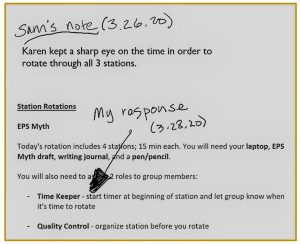
Following a visit to my classroom this year, Sam Uzwack emailed me his observations, most of which were NOT intended as recommendations; he had simply written down what he had observed. One of his notes read, “Karen kept a sharp eye on the time in order to rotate through all 3 stations.” Not a recommendation at all. The simple note, though, made me see the situation through different eyes. The point of the Station Rotation was to encourage students to work independently; if I was really promoting independence, I wouldn’t be watching the clock – they would! I was able to receive the feedback and respond to and apply it in a positive way because I trusted that my colleague had best intentions.
(2) displays openness and comfort with visitors observing class
Having visitors observe my class is something I have had to learn to be comfortable with over the years. In our Middle School, teachers and students consistently pop in and out of classrooms. Much of the time it’s to ask a quick question, but sometimes the visit is for an extended time and for any variety of reasons. Positive experiences with classroom visits, as well as trusting relationships, have helped me gain confidence in and see the value of such practices. I now welcome it and look forward to hearing what others see and learn about my teaching.
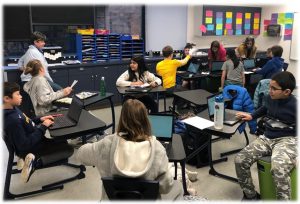
Visit examples:
- Paul Hagen and Sam Uzwack were passing by my Intro to Lit classroom one morning. They peeked through the window, I waved them in, and they then got to participate in the day’s Attendance Question.
- Several years ago I participated in another year-long professional development opportunity that required classroom visits. Each member of my team visited at least once, and the conversations that resulted were rich in pedagogy and developed each of our practices.
- For many years, prospective students visited my classes during their visit days, or I taught mock classes that were also observed by the admission team.
(3) seeks out diverse opinions of others for guidance
While there is a core group of colleagues whom I regularly seek out for guidance, I also reach out to others on occasion in order to gain a broader perspective. The core group helps me prepare for regular activities – planning classes and leading advisory activities, for instance. For special occasions, though, a wider swath of ideas and perspectives is warranted.
A few “special occasion” kinds of guidance are as follows:
- The Student Support Services team are a critical source of guidance when I am working with an individual student who has (or needs) learning accommodations. This team helps me craft assignments and tailor plans to suit individual students; typically, their guidance informs me of a better way to improve clarity of assignments for all students, if truth be told.
- As we developed curricula for the New Parent Series, Anthony Colello and I presented our ideas to the whole middle school faculty and asked for their feedback. We then incorporated many of their ideas in to the program.
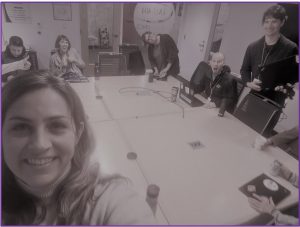
- As part of this PDP process, I got to take one of my classroom projects through a “module tuning” with the Curriculum Committee. I presented the details of the EPS Myth to a team made up of discipline reps and senior leadership members, and asked them to make suggestions about how to streamline (or eradicate?!) the grading part of the project.
(4) manages and prioritizes professional tasks and responsibilities
While this indicator is not especially exc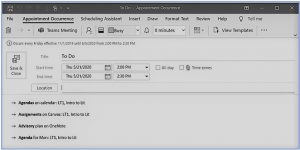 iting to write or read about, the ability to manage and prioritize my list of tasks and responsibilities has become increasingly important over the years as I have acquired more of each. One of the main ways that I organize tasks is with my weekly “To Do” Outlook appointment. This recurring appointment shows up on my calendar on the last work day of each week, reminding me to prepare for the following week before I go home. Are assignments up on Canvas? Does my advisor team know what the plans are for the week? I won’t let myself leave campus until these items are complete. This helps me wind down each week and ramp up for the next.
iting to write or read about, the ability to manage and prioritize my list of tasks and responsibilities has become increasingly important over the years as I have acquired more of each. One of the main ways that I organize tasks is with my weekly “To Do” Outlook appointment. This recurring appointment shows up on my calendar on the last work day of each week, reminding me to prepare for the following week before I go home. Are assignments up on Canvas? Does my advisor team know what the plans are for the week? I won’t let myself leave campus until these items are complete. This helps me wind down each week and ramp up for the next.
There are a couple of other tricks that I use regularly to manage my work load. Similar to the “To Do” list, I will schedule appointments in Outlook for specific tasks. If I need to write a section of the PDP, for instance, I reserve the time on my calendar as a reminder and gentle push. I have also reached a point in my tenure at which I have learned to say no to requests that 1) fall outside of my responsibilities and 2) might cause undue stress or a big time commitment. So many activities at EPS are wonderful opportunities for students, and I believe that we all have a responsibility to participate when we can. However, when I feel spread too thin, or am committed to too many different things, everything suffers as a result. A focus on fewer things often equates to better outcomes in the long run.
(5) communicates and responds to students, parents, and colleagues in a timely and constructive manner
Communication is a critical component in sustaining our strong culture of community. Conversations in person, over the phone, and via email occur all day every day. Any conversation, regardless of mode, that I have with colleagues, parents, or students is based on a foundation of trust and respect, which must be built up over time. In any type of communication, I strive to be kind, straightforward, solution-oriented, and honest. I aim to give the benefit of doubt in all situations.
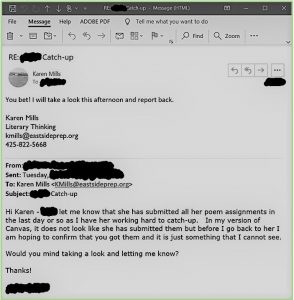
Emails are a main mode of communication at EPS and, as we all know, can consume already tightly packed days. I have developed a few successful approaches to responding to email, starting with reading messages only when I have time to respond appropriately. If I need to check for a single reply but don’t have time to respond to each and every message, I might mark some messages as unread, an indicator to me that I need to go back to it. If an email comes through that requires a detailed response, I try to respond immediately with a quick note: “Hi! Thanks for your email. I’m going to need some time to look into that … I will have time later today and then will get back to you.” I create time in my day, then, to respond fully and thoughtfully. As a main vein of communication, emails are important to get right.